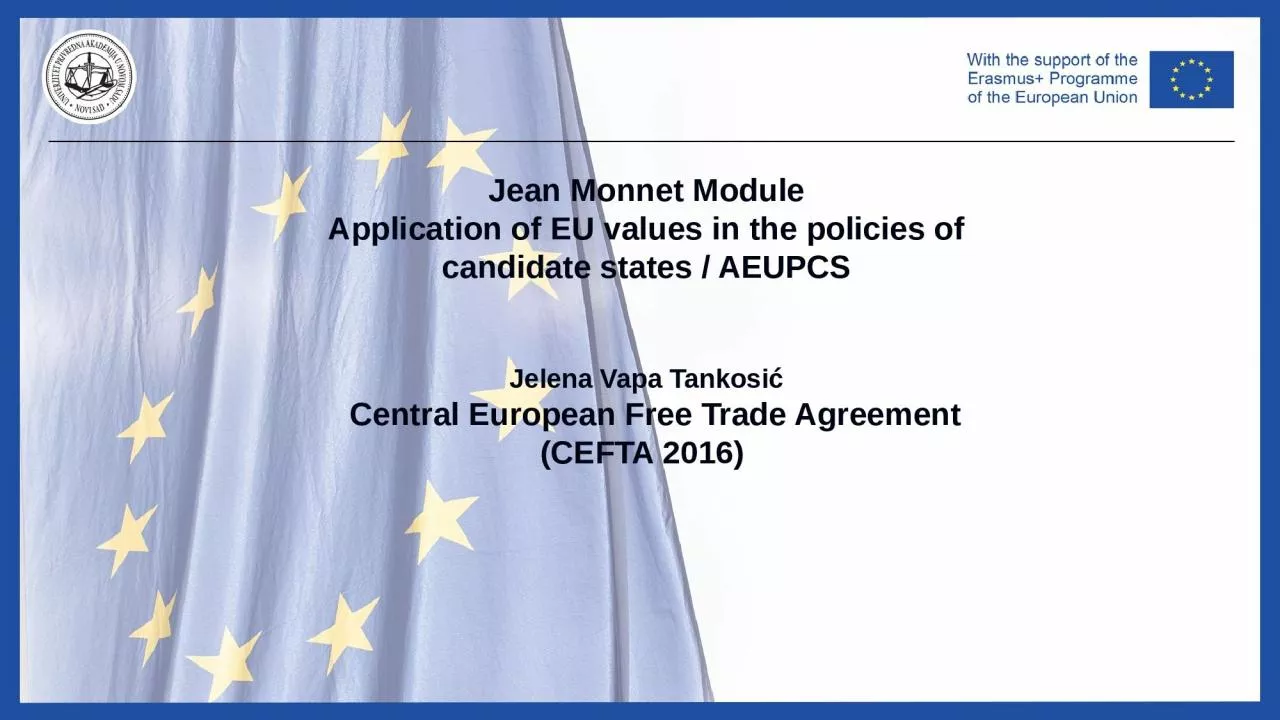

Jelena Vapa Tankosić Central European Free Trade Agreement CEFTA 2016 Central European Free Trade Agreement CEFTA 2016 The S tabilization and association process H armonization ID: 1027640
Download Presentation The PPT/PDF document "Jean Monnet Module Application of EU val..." is the property of its rightful owner. Permission is granted to download and print the materials on this web site for personal, non-commercial use only, and to display it on your personal computer provided you do not modify the materials and that you retain all copyright notices contained in the materials. By downloading content from our website, you accept the terms of this agreement.
1. Jean Monnet ModuleApplication of EU values in the policies of candidate states / AEUPCSJelena Vapa Tankosić Central European Free Trade Agreement (CEFTA 2016)
2. Central European Free Trade Agreement (CEFTA 2016) The Stabilization and association processHarmonization of legal regulations with Community law.Adjusting the economic system to the conditions of the large European market by strengthening the economy so that it can function successfully in conditions of strong competition.One of the most significant results of this process is the creation of free trade zones, which are created on the basis of bilateral or multilateral free trade agreements.
3. Central European Free Trade Agreement (CEFTA 2016) The Treaty establishing CEFTA was signed on December 21, 1992 in Krakow, Poland.CEFTA (Central Europe Free Trade Agreement) is a preferential agreement that originated in 1992 and which then included Central European countries, such as Poland, Czechoslovakia and Hungary.Under the auspices of the Stability Pact for Southeast Europe, and in connection with the Stabilization and Association Process, a decision was made to expand the current CEFTA, by acceding to the agreement of the countries of Southeast Europe.
4. Central European Free Trade Agreement (CEFTA 2016) The idea of creating a single multinational agreement that would streamline and facilitate the implementation of the provisions of a network of 32 bilateral agreements.resulted in the "Agreement amending and acceding to the Central European Free Trade Agreement (CEFTA 2006)", signed on 19 December 2006 in Bucharest.
5. Central European Free Trade Agreement (CEFTA 2016) Founded by representatives of Poland, Hungary and Czechoslovakia, CEFTA expanded to Albania, Bosnia and Herzegovina, Bulgaria, Croatia, Moldova, Montenegro, North Macedonia, Romania, Serbia, Slovenia and the UNMIK (on behalf of Kosovo, in accordance with UNSCR 1244).Former parties are Bulgaria, Croatia, Czech Republic, Hungary, Poland, Romania, Slovakia, and Slovenia. The CEFTA memberships ends when parties became member states of the European Union (EU).
6. Central European Free Trade Agreement (CEFTA 2016) the principles, provisions and regulations applicable in CEFTA apply in both the WTO and the EU.building the institutions needed for WTO and EU accession.encourages the EU integration process, by harmonizing with the acquis and EU standards.The EU supported and highlighted the conclusion of the CEFTA 2006 agreement as one of the priorities of its regional policy in the Western Balkans.
7. CEFTA statistics portal- Republic of Serbiahttps://statistics.cefta.int/home
8. Central European Free Trade Agreement (CEFTA 2016) The CEFTA region is one of the few markets with which Serbia has a continuous trade surplus.According to the share in the total export of Serbia, that market is the second most important, after the European Union market.Liberalization of trade with CEFTA signatories has significantly increased the volume of trade between Serbia and other signatory countries to the agreement and thus placed CEFTA countries in a high place in terms of trade volume.
9. Further readingS. Mojsovska (2019) ‘The Western Balkans on its path to the European Union’, Yearbook of the Institute of East-Central Europe, vol. 17, no. 4, pp. 9-24, DOI: https://doi.org/10.36874/RIESW.2019.4.Baldwin, R., Wyplosz, C. (2004). The Economics of European Integration, McGrawHill, London.Senior Nello, S. (2009). The European Union: Economics, Policy and History, McGraw-Hill, London.Jovanović, M. (2004). Evropska ekonomska integracija, Ekonomski fakultet u Beogradu, Beograd.Budimir, B. Međak (2017). Vodič kroz pristupanje Srbije Evropskoj uniji, 5. dopunjeno izd., ISAC fond, Beograd.
10. Further readingMedović, V., Vapa-Tankosić, J. (2017). Izazovi u primeni Sporazuma o stabilizaciji i pridruživanju i pravnih tekovina Evropske unije, Fakultet za ekonomiju i inženjerski menadžment, Novi Sad. ISBN 978-86-87619-90-6.Medjak, V. (ed.). (2018). Effects of Stabilisation and Association Agreements and CEFTA2006 on WB6 European Integrationand Regional Cooperation: Achievements and Ways Forward. European Movement in Serbia, Belgrade. European Commission, Serbia 2019 Report, 2019, https://ec.europa.eu/neighbourhood-enlargement/sites/near/files/20190529-serbia-report.pdf